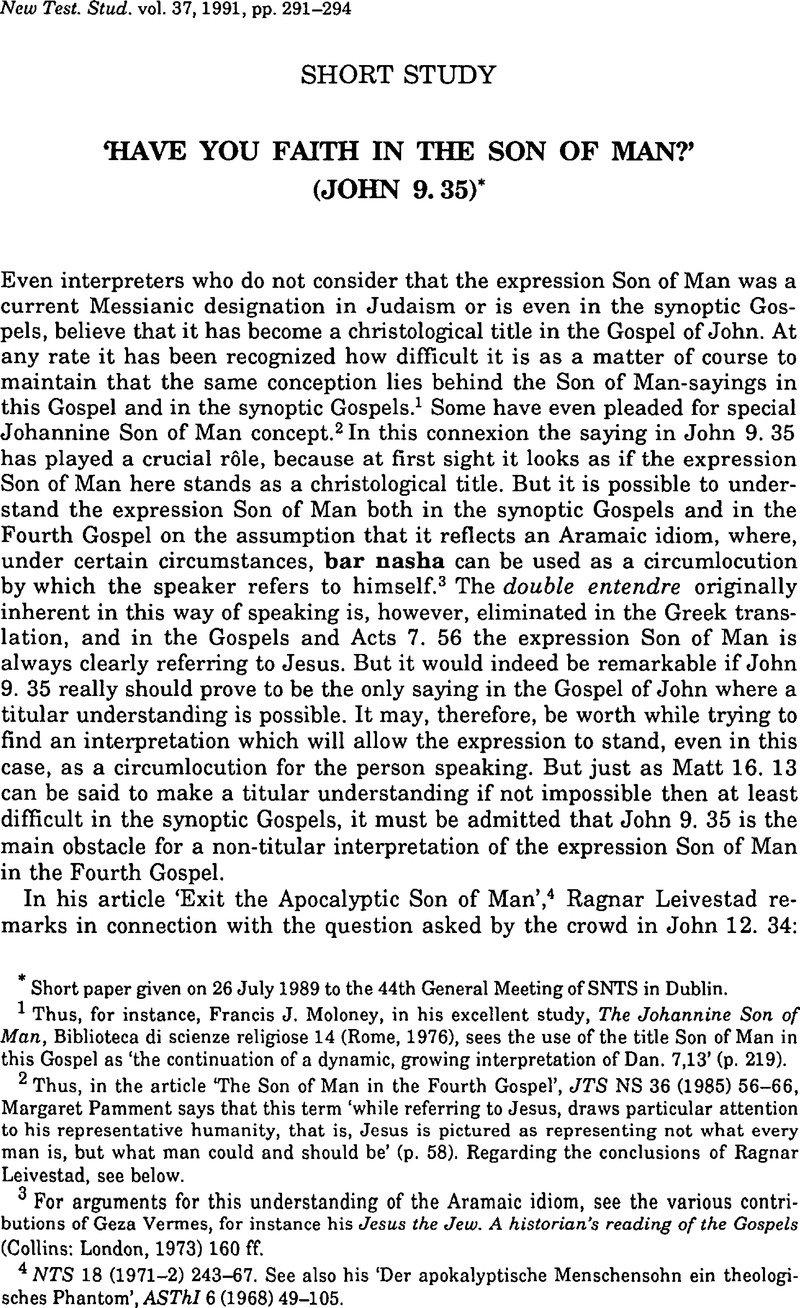Article contents
‘Have you Faith in the Son of Man?’ (John 9.35)*
Published online by Cambridge University Press: 05 February 2009
Abstract

- Type
- Short Study
- Information
- Copyright
- Copyright © Cambridge University Press 1991
References
1 Thus, for instance, Francis J. Moloney, in his excellent study, The Johannine Son of Man, Biblioteca di scienze religiose 14 (Rome, 1976), sees the use of the title Son of Man in this Gospel as ‘the continuation of a dynamic, growing interpretation of Dan. 7,13’ (p. 219).
2 Thus, in the article ‘The Son of Man in the Fourth Gospel’, JTS NS 36 (1985) 56–66Google Scholar, Margaret Pamment says that this term ‘while referring to Jesus, draws particular attention to his representative humanity, that is, Jesus is pictured as representing not what every man is, but what man could and should be’ (p. 58). Regarding the conclusions of Ragnar Leivestad, see below.
3 For arguments for this understanding of the Aramaic idiom, see the various contributions of Geza Vermes, for instance his Jesus the Jew. A historian's reading of the Gospels (Collins: London, 1973) 160 ff.Google Scholar
4 NTS 18 (1971–1972) 243–67Google Scholar. See also his ‘Der apokalyptische Menschensohn ein theologisches Phantom’, ASThI 6 (1968) 49–105.Google Scholar
5 See ‘Exit the Apocalyptic Son of Man’, 251.
6 See ‘Exit the Apocalyptic Son of Man’, 253. Leivestad finds in John 5. 27 the key to an understanding of the content of this term.
7 See my ‘Der Ausdruck “Menschensohn” in den Evangelien. Voraussetzungen und Bedeutung’, AThD 17 (1984) 214Google Scholar ff. Cf. the review by Leivestad, Ragnar, ‘Betydningen av uttrykket “menneskesønnen”’, DTT 48 (1985) 172–94, especially 191 f.Google Scholar
8 See the apparatus by Nestle-Aland, , Novum Testamentum Graece, 26. Auflage 1979 and later editions.Google Scholar
9 Vol. V (1967, German edition 1954), see especially 362–5.Google Scholar Cf. also for instance, Rudolf, Bultmann, Theologie des Neuen Testaments (5 1965) 423 ff.Google Scholar
10 TDNTV (1967) 363–4.Google Scholar
11 See, for instance, Bultmann, , Theologie, 422 f.Google Scholar
12 Vol. VIII (1972) 465 (= German edition 1967, p. 469).Google Scholar
13 Here I may refer to ‘Der Ausdruck “Menschensohn” in den Evangelien’, 142–6, 205–18Google Scholar, for further arguments. Cf, however, also Dorman, David A., ‘The Son of Man in John: A Fresh Approach through Chapter 6’, Studia Biblica et Theologica 13 (1983) 121–42Google Scholar, who (p. 125) rightly maintains, that ‘the study of Son of Man in John ought to begin with a study of the relevant passages in John, submitting them to examination based on internal literary, theological, and stylistic factors, before bringing factors from the wider sphere of Christian testimony into consideration’. In John 6 Son of Man is, according to Dorman, ‘the confronting Revealer’, but in such a way that ‘the use of the title is a test of faith rather than a profession of faith’ (p. 134), and he concludes that in the Gospel of John ‘Son of Man’ ‘has no character as such, but is only a function, a role’ (p. 138). But this function, this role is the function and role of Jesus in the christology of the Fourth Gospel and is not reflecting any Son of Man concept.
- 3
- Cited by




